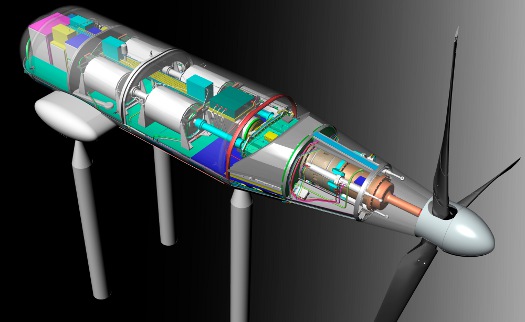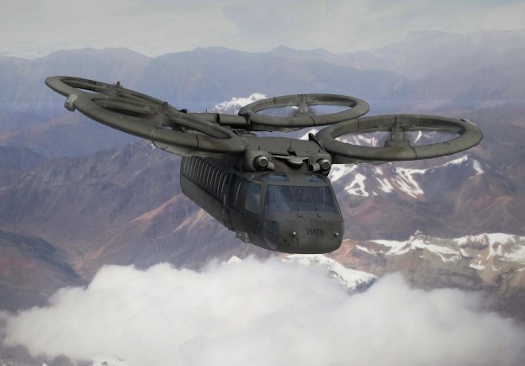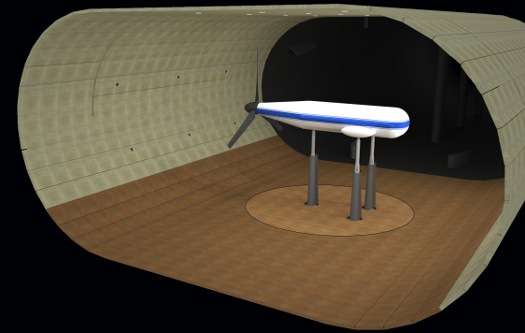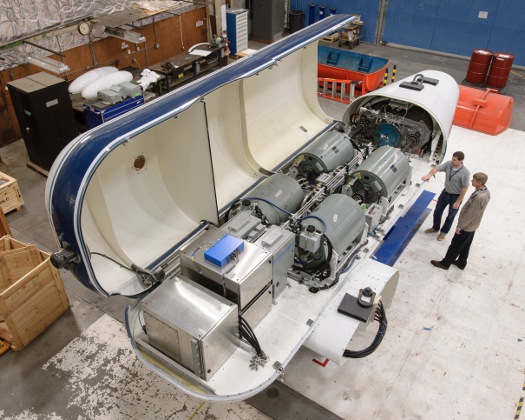 |
| July 25, 2017 | Volume 13 Issue 28 |
Designfax weekly eMagazine
Archives
Partners
Manufacturing Center
Product Spotlight
Modern Applications News
Metalworking Ideas For
Today's Job Shops
Tooling and Production
Strategies for large
metalworking plants
NASA fires up unique tiltrotor test rig in biggest wind tunnel in the world

Design concept for the Tiltrotor Test Rig, showing internal components of the control system, motors, and gearbox. [Credits: NASA]
Someday, we may be able to commute to our jobs in aircraft that can take off and land like a helicopter, but fly like a plane. Developing these advanced tiltrotors is no simple task, so NASA has been installing a new rig that will let experts test them at an unprecedented scale in wind tunnels, where pilots' lives won't be on the line.
The new Tiltrotor Test Rig (TTR) got its first functional trial in March at NASA's Ames Research Center in Silicon Valley, CA. The testing is taking place in the biggest wind tunnel in the world -- the National Full-Scale Aerodynamics Complex (NFAC).
"This first test is a functional checkout," Gorton said. "Because TTR is so large, we've never been able to spin it with the rotor blades installed. This will be the first time that the system will be completely assembled and operated. If we find any anomalies, we'll circle back to fix those. Our goal is to have our system completely checked out, so we can have confidence in it."
The name tiltrotor reflects the ability of the rotors on the wings of these hybrid craft to shift from a helicopter-like orientation to an airplane-like orientation. The former lets the aircraft take off vertically, hover, and land without a runway; the latter gives it greater forward speed.

Artist conception of future Army rotorcraft. [Photo Credit: U.S. Army graphic by AMRDEC VizLab]
Today, aviation is moving increasingly in the direction of tiltrotors. Although only one such craft currently is in production -- the V-22 Osprey, used by the U.S. Marines -- tiltrotors are expected to enter the commercial aviation market in 2018.
"With a tiltrotor, you get a lot more range and speed than a helicopter, but it's still able to hover, which gives you good accessibility in remote locations," said Susan Gorton, lead for the Revolutionary Vertical Lift Technology project at NASA's Langley Research Center in Hampton, VA.

The tiltrotor V-280 Valor aircraft is Bell Helicopter's vision of the future for the U.S. Army. [Photo Credit: Artist's rendering courtesy Bell Helicopter]
Anticipated civil uses for tiltrotor aircraft include offshore oil operations and executive transport. NASA is particularly interested in technologies for large configurations that could be used in commuter transport between cities.
Unprecedented in size and speed
Before those applications can be developed, large, high-performance tiltrotor systems need to undergo exhaustive testing. The TTR is a horizontal axis rig and rotates on the test-section turntable to face the rotor into the wind at high speed or fly edgewise at low speed or at any angle in between. When the TTR gets up and fully running, it will be unique in its ability to handle rotors up to 26 ft in diameter, capable of reaching speeds of 300 knots (345 mph).
"Other facilities out there test tiltrotor designs at much smaller scales, and then jump immediately to flight. They don't have this advantage of being able to test at large scales," Gorton said. "This is important, because we think the scale can have an impact on the test performance."
The TTR is designed to accommodate a variety of rotors. A 26-ft-diameter research rotor has been used for the first test. For maximum accuracy, rotor forces are measured by a dedicated balance installed between the gearbox and the rotor. Rotor torque is measured by an instrumented drive shaft. The TTR has four electric motors capable of 5,000 hp total -- enough to drive proprotors far more capable than any currently in existence at this scale.

This computer rendering shows the TTR once installed in the huge wind tunnel. [Credits: NASA]
NASA already was leading the way on advanced rotorcraft research in the 1970s, notably with the flight demonstrations of the XV-15 tiltrotor and other large-scale testing. In recent years, in a joint project with the Army and the Air Force, NASA has been working to replace the previous test hardware with a system of even greater capability.
Their efforts have culminated in the new TTR, which will pave the way for future tiltrotors by enabling NASA to test rotors producing more thrust and achieving higher speeds than any that exist today. The facility will provide a resource for the nation's aviation research community to test specific rotor configurations, including those developed by private industry.

The Tiltrotor Test Rig with its aerodynamic shell open. Each of the four gray cylinders is a 1,250-hp electric motor. [Credits: NASA]
Fundamental aerodynamics research is also in TTR's future. Projects conducted aim to provide a better understanding of what makes these rotors efficient, quantify the relative efficiencies of different configurations, and look for ways to improve upon the concept.
Further research and development could mean that, down the road, you'll hop on your local tiltrotor aircraft to fly to work. The special rotors getting you there may well have taken their first spin at NASA Ames.
Summary of TTR design capabilities (from NASA)
- Wind speed: 300 knots axial, 180 knots edgewise (the exact limit is determined by dynamic pressure, hence atmospheric conditions)
- Rotational speed: from 126 to 630 rpm
- Rotor thrust: 20,000 lb steady; 30,000 lb peak
- In-plane force (resultant): 5,000 lb steady; 10,000 lb peak
- Moment (resultant): 30,000 ft-lb steady; 60,000 lb peak
- Shaft torque: 48,000 ft-lb steady; 72,000 lb peak
- Power: 6,000-hp max (presently qualified for 2 hr at 5,000 hp)
UPDATE: Aug. 2, 2017
Darryl Waller, Public Affairs Officer, NASA's Ames Research Center in Silicon Valley, gave Designfax this exclusive update on the Tiltrotor Test Rig Aug. 2, 2017:
"The Tiltrotor Test Rig was installed in the National Full-Scale Aerodynamics Complex (NFAC) 40- x 80-ft test section on March 7, 2017. Preparatory tests included an extensive vibration test. Aerodynamic tares (baseline measurements without the rotor) were taken up to 275 knots, the maximum possible airspeed. The rotor was installed on May 23 and began operations on June 9 with a successful track and balance run.
"On Jun 10, the wind tunnel suffered a mishap during an unrelated test. The TTR was not affected, but further operations are on hold until the US Air Force completes its investigation of the NFAC mishap."
Source: Ames Research Center
Published July 2017
Rate this article
View our terms of use and privacy policy
